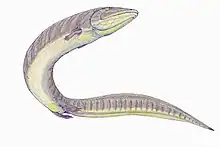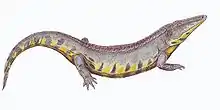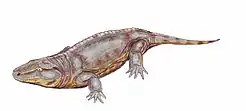Spondylerpeton
Spondylerpeton is an extinct genus of tetrapod closely related to "Cricotus"[1] (Archeria) in the family Archeriidae.[2] This genus is known from fragmentary remains, namely a short series of tail vertebrae preserved in an ironstone nodule. These remains were found in the Mazon Creek beds of Illinois, an area famed for its preservation of Carboniferous plants and animals.[3][4] Spondylerpeton individuals were probably about three to four feet in length, by far the largest animals known to have inhabited the Mazon Creek area during this era.[1]
| Spondylerpeton Temporal range: Late Carboniferous, | |
|---|---|
| Scientific classification | |
| Domain: | Eukaryota |
| Kingdom: | Animalia |
| Phylum: | Chordata |
| Order: | †Embolomeri |
| Family: | †Archeriidae |
| Genus: | †Spondylerpeton Moodie, 1912 |
| Type species | |
| †Spondylerpeton spinatum Moodie, 1912 | |
References
- Moodie, Roy L. (January 1912). "The Pennsylvanic Amphibia of the Mazon Creek, Illinois". The University of Kansas Science Bulletin. 6 (2): 323–359.
- Panchen, A.L. (10 June 1977). "On Anthracosaurus russelli Huxley (Amphibia: Labyrinthodontia) and the Family Anthracosauridae". Philosophical Transactions of the Royal Society of London. Series B, Biological Sciences. 279 (968): 447–512. doi:10.1098/rstb.1977.0096.
- Moodie, Roy Lee (1916). "The Coal Measures Amphibia of North America". Carnegie Institution of Washington. 238: 1–222.
- Romer, Alfred Sherwood (1930). "The Pennsylvanian tetrapods of Linton, Ohio" (PDF). Bulletin of the American Museum of Natural History. 59 (2): 78–147.
This article is issued from Wikipedia. The text is licensed under Creative Commons - Attribution - Sharealike. Additional terms may apply for the media files.





